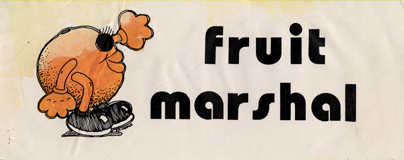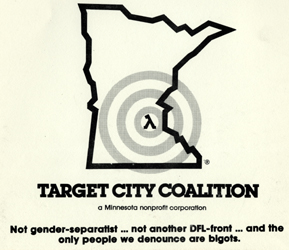Difference between revisions of "National Fruit Day"
(table +table) |
|||
| (4 intermediate revisions by 3 users not shown) | |||
| Line 4: | Line 4: | ||
| − | + | {{unprotected}} | |
{| {{prettytable}} | {| {{prettytable}} | ||
! | ! | ||
! | ! | ||
|- | |- | ||
| − | | | + | | Anita Bryant is arguably the most recognizable antigay figure in the Post-Stonewall Era. Following her debut as a runner-up in the 1959 Miss America pageant, Bryant experienced moderate success in the music industry during the 1960s. By 1970, Bryant was a spokeswoman for the Florida Citrus Commission<small>(1)</small>—she also appeared in commercials Coca-Cola<small>(2)</small> and Kraft Foods.<small>(3)</small> |
| <div style="text-align: center;"> | | <div style="text-align: center;"> | ||
[[Image:Svc_fruitmarshal.jpg]] | [[Image:Svc_fruitmarshal.jpg]] | ||
</div> <div style="text-align: center;"> | </div> <div style="text-align: center;"> | ||
| − | '''<small>"Fruit Marshals" were assigned to oversee the event. They represented the worst of Anita Bryant's fears--"militant homosexual activists." Courtesy of | + | '''<small>"Fruit Marshals" were assigned to oversee the event. They represented the worst of Anita Bryant's fears--"militant homosexual activists." Courtesy of the [[Jean-Nickolaus Tretter Collection]].</small>''' |
</div> | </div> | ||
|} | |} | ||
| Line 31: | Line 31: | ||
'''L<small>ogo of Target City Coalition, which organized the event. Target City was the Minneapolis counterpart to the [[St. Paul Citizens for Human Rights]]. Courtesy of the [[Jean-Nickolaus Tretter Collection]].</small>''' | '''L<small>ogo of Target City Coalition, which organized the event. Target City was the Minneapolis counterpart to the [[St. Paul Citizens for Human Rights]]. Courtesy of the [[Jean-Nickolaus Tretter Collection]].</small>''' | ||
</div> | </div> | ||
| − | | Located in a southeast Minneapolis industrial park, the company’s entrance was only accessible by a frontage road that stretched without interruption for miles. Organizers of National Fruit Day took advantage of this—the protest’s 750 participants lined either side of the street to “welcome” Bryant and her entourage. | + | | Located in a southeast Minneapolis industrial park, the company’s entrance was only accessible by a frontage road that stretched without interruption for miles. Organizers of National Fruit Day took advantage of this—the protest’s 750 participants lined either side of the street to “welcome” Bryant and her entourage.<small>(4)</small> |
| − | A smaller group of Anita supporters made it to the event as well, but both groups managed to appease the police and keep their distance. Police only intervened when a young man attempted to give Mrs. Bryant a bag of rotting grapefruits. | + | A smaller group of Anita supporters made it to the event as well, but both groups managed to appease the police and keep their distance. Police only intervened when a young man attempted to give Mrs. Bryant a bag of rotting grapefruits. Bryant's response? "Bitter Fruit. Bitter Fruit."<small>(5)</small> |
|} | |} | ||
| + | ---- | ||
| + | ==This entry is part of:== | ||
| + | == [[Minneapolis/St. Paul, MN: 100 Queer Places in Minnesota History, (1860-2010)]]== | ||
| + | ---- | ||
| + | |||
| + | |||
| + | <small>(1)</small>Bullough, Vern (LeRoy) "Anita Bryant" From ''Who's Who in Contemporary Gay and Lesbian History: From World War II to the Present Day.'' New york: Routledge, 2001. Page 63. | ||
| + | <small>(2)</small>Pendergrast, Mark. ''For God, Country, & Coca-Cola: The Definitive History of the Great American Soft Drink and the Company that Made It.'' New York, Basic Books, 1993, 2000. Page 272. | ||
| + | <small>(3)</small>Bullough, ''ibid''. | ||
| − | + | <small>(4)</small>Davies, Tom. "750 Prostest at Anita Bryant Performance." ''The Minneapolis Tribune'', 5/22/1977. Page 1A. | |
| − | |||
| − | + | <small>(5)</small>Davies, page 11A. | |
Latest revision as of 05:38, 2 February 2012
740 Kasota Avenue SE, Minneapolis
| Anita Bryant is arguably the most recognizable antigay figure in the Post-Stonewall Era. Following her debut as a runner-up in the 1959 Miss America pageant, Bryant experienced moderate success in the music industry during the 1960s. By 1970, Bryant was a spokeswoman for the Florida Citrus Commission(1)—she also appeared in commercials Coca-Cola(2) and Kraft Foods.(3) | "Fruit Marshals" were assigned to oversee the event. They represented the worst of Anita Bryant's fears--"militant homosexual activists." Courtesy of the Jean-Nickolaus Tretter Collection. |
Her career in advertising funded her simultaneous career as an anti-gay activist—these two occupations were frequently at odds with one another. With frequent death threats, protests, and hate mail surrounding her every move, the “Orange Juice Lady” had occasional difficulty selling her products. This was the case on May 21st, 1977, when locals commemorated a short visit by the singer with “National Fruit Day” just days before the vote in Dade County. The name alluded to Bryant’s preferred name for queer people—fruits—as it simultaneously played on the campy irony of her visit. Mrs. Bryant came to the Twin Cities to commemorate the opening of a wholesale fruit company.
| Logo of Target City Coalition, which organized the event. Target City was the Minneapolis counterpart to the St. Paul Citizens for Human Rights. Courtesy of the Jean-Nickolaus Tretter Collection. |
Located in a southeast Minneapolis industrial park, the company’s entrance was only accessible by a frontage road that stretched without interruption for miles. Organizers of National Fruit Day took advantage of this—the protest’s 750 participants lined either side of the street to “welcome” Bryant and her entourage.(4)
|
This entry is part of:
Minneapolis/St. Paul, MN: 100 Queer Places in Minnesota History, (1860-2010)
(1)Bullough, Vern (LeRoy) "Anita Bryant" From Who's Who in Contemporary Gay and Lesbian History: From World War II to the Present Day. New york: Routledge, 2001. Page 63.
(2)Pendergrast, Mark. For God, Country, & Coca-Cola: The Definitive History of the Great American Soft Drink and the Company that Made It. New York, Basic Books, 1993, 2000. Page 272.
(3)Bullough, ibid.
(4)Davies, Tom. "750 Prostest at Anita Bryant Performance." The Minneapolis Tribune, 5/22/1977. Page 1A.
(5)Davies, page 11A.

